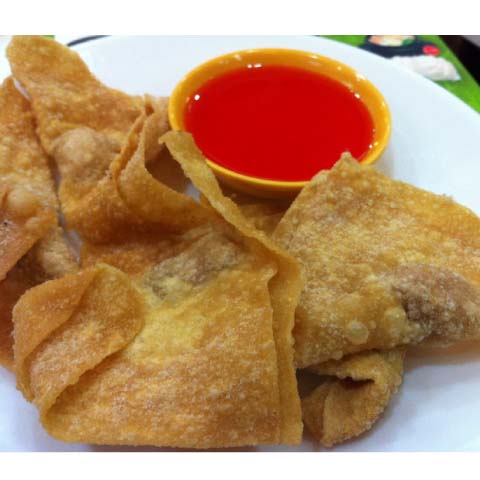This saga all started from the name of a special mami and siopao restaurant along C. M. Recto Avenue near Avenida – Pinsec House.
Pinsec sounds Chinese. But what does it mean? What is its Chinese origin? Is it related somehow to pansit, the popular Filipino dish?
After consulting with a local-born Tsinoy who is almost 60, I learned for the first time that pinsek refers to dumplings, a famous Chinese dish, particularly fried ones. Since childhood, that friend recalls, he, his mother and siblings refer to fried dumplings as pinsek.
But how come Chinese dumplings are called pinsek even by Tsinoys? It is fortunate that I also know Cantonese, and this helped when I saw on the wall of a dumpling house in Beijing an introduction to the history of dumplings in China.
Dumplings in Chinese is generally referred to as jiao zi (餃子), but it has also been called bian shi (扁食) since the Yuan (元) Dynasty (1206-1368). Bian shi in Cantonese is exactly pinsek! But the word pinsek is not limited to this Chinese dish of dumplings. Further research points to its relation with the word pansit.
A Chinese scholar at Peking University once explained to me the term pansit in Filipino probably originated from the term 扁食 which is pronounced in Hokkien as pian sit and sounds similar to pansit. Since we have established that 扁食 refers to dumplings with its Filipino term pinsek, derived from the Cantonese pronunciation, is it possible that 扁食 refers also to pansit, the Filipino noodle dish?
Up to the present, the Chinese origin of the term pansit is generally traced to the Hokkien word pian sit (便食), which literally means convenient (便) food (食). But, is that really the case?
In the first place, when Fujianese (Hokkien people) say eat, they pronounce it as “tsia” and never as “sit.” It is the Cantonese who say “sek” when they talk about eating. For example, the Fujianese would say “tsia mï” when referring to the Chinese word food 食物, although literally they may pronounce it as “sit boot.” But you cannot relate “tsia mï” or “sit boot” to pansit’s pronunciation, right?
Moreover, the Chinese, either Fujianese or Cantonese, never call noodles as piansit (便食). Plus, there is no such term in Chinese vocabulary.
As to noodles, or pansit in Filipino, the Fujianese simply call it “mi” (麵) while the Cantonese would say “mīn.” It must be noticed that the Chinese term 麵 refers both to flour and noodles. Further, the Chinese language has a particular term that refers to all kinds of food made of flour: 麵食 (“mian shi” in Mandarin, “mi sit” in Hokkien, “mīn sek” in Cantonese). 麵食 in fact includes noodle dishes, referred to as “mīn sek” in Cantonese, which sounds approximately like pansit in Filipino. The Cantonese in the Philippines pioneered in the restaurant or panciteria business. So, it is more likely that the pansit in Filipino for noodles originated from the Chinese term for noodles 麵食.
Lastly, allow me to list down all the varieties of pansit in the Philippines which vividly illustrate how the Chinese noodle culture or 麵食 has been well-integrated in Philippine food culture.
• Buko Pancit (Quezon province)
• Pancit Abra (Abra province)
• Pancit Alanganin
• Pancit ni Juli
• Pancit Alahoy
• Pancit Batchoy
• Pancit Bato (Bato, Camarines Sur)
• Pancit Bihon (or bijon)
• Pancit Bihongundoy
• Pancit Cabagan
• Pancit Canton
• Pancit Canton Ilonggo
• Pancit Chami (Lucena, Quezon)
• Pancit Estacion (Tanza, Cavite)
• Pancit Habhab (Lucban, Quezon)
• Pancit Kilawin (Rosario, Cavite)
• Pancit Kinalas (Naga City, Camarines Sur)
• Pancit Lanu (San Vicente Street, San Pedro, Laguna)
• Pancit Lomi (Batangas)
• Pancit Luglug or Luglog
• Pancit Lucban
• Pancit Luglog
• Pancit Malabon
• Pancit Mami
• Pancit Mayaman (Guinayangan, Quezon)
• Pancit Miki
• Pancit Míki-Bíhon
• Pancit Olongapo
• Pancit Molo
• Pancit Moròng
• Pancit Palabok
• Pancit Pula (Batangas City)
• Pancit Pusit
• Pancit Sotanghon
• Pansit Sabaw
• Pansit Tuguegarao or Batil Patong
• Pansit Sinanta (Tuguegarao, Cagayan)
Categories
Pansit and pinsek
